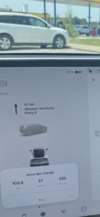2021 MYP March build, 82kwh pack. 6,000 miles on odometer. My estimated mileage varies quite a bit, between 280-300mi. Sometimes the 100% SOC estimate will show low 280s, other times it will be in 290s. It’s interesting how mine varies so much with such few miles, but I’m not overly worried about that low number. Daily charge usually set between 60-80% except for trips I charge 100%
I routinely take a 225mi all highway trip door-to-door with this car, and although my number estimate has dropped under 300mi at 100% charge, what is interesting to me is that my SOC on arrival has essentially remained unchanged since it was new on this predictable/repeatable drive. Typically driving 78-80mph on autopilot, using 310-320ish wh/mi, 71-73Kw from trip computer, and have always arrived with a few percent remaining.
This means that my usable range in the car has not actually degraded like the BMS sometimes suggests when displaying lower EPA mileage estimate numbers at me.
Same here (see earlier post). %SOC is a real number. Range is a construct - a living, breathing, animal that varies by constantly changing conditions. We worry too much. Cheers.



